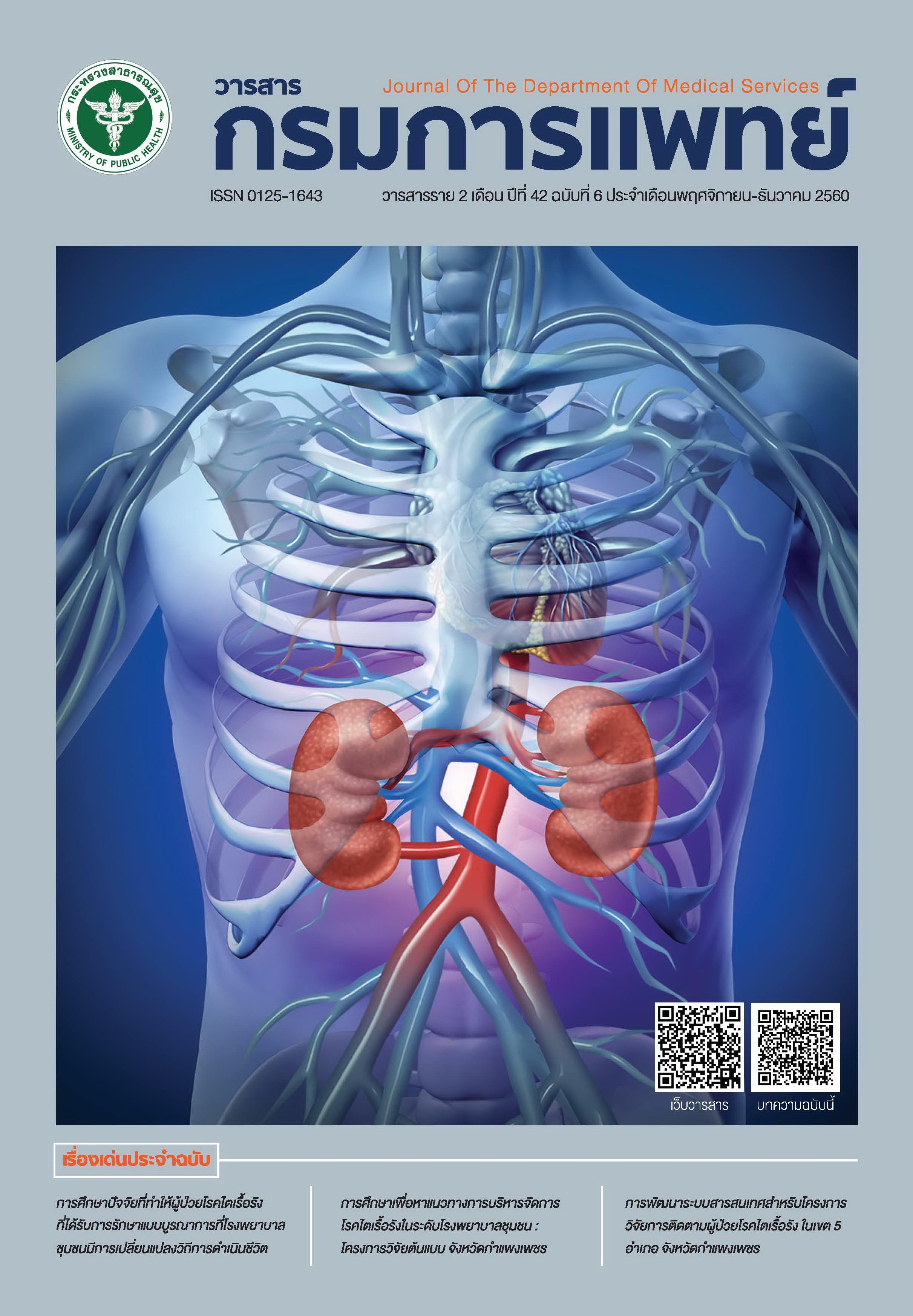Developing a Model of Care for the Multiple Trauma Hypovolemic Shock Patients in Sawanpracharak Hospital
Keywords:
Multiple trauma patient care model, Hypovolemic shock, Multiple trauma patientsReferences
National Statistical Office, Ministry of Information and Communication Technology. Road traffic accident statistics from 2549-2558. Avaiilable from: URL: http://service.nso. go.th/nso/web/statseries/statseries.
Newberry L. Emergency nursing principle and practice. Philadephia: Mosby National Institute for Clinical Excellence 2001.Avaiilable January 7, 2017, form URL: http://www. nice.org.uk.
Nicola C, Sally H, Carolyn D, Chris H, Karim B, Simon S. The acute management of trauma hemorrhage: a systematic review of randomized controlled trials. Critical Care 2011; 15-92.
Chad MC, Carla CB, Mendy KS, Jonathan DM, Elizabeth C, Michael M. Utility of the Shock Index in Predicting Mortality in Traumatically Injured Patients. The Journal of TRAUMA Injury, Infection, and Critical Care 2009; 67: 1426-30.
Kevin FM, Jose DC, Juan SC, Luis RN, Gustavo P. Shock index as a mortality predictor in patients with Acutepolytrauma.Journal of Acute Disease 2015; 4: 202–4.
Schumacher KL, Meleis AI. Transitions: a central concept in nursing. Image J Nurs Sch 1994; 26:119-27.
Meleis AI, Sawyer LM, Im EO, Hilfinger Messias DK, Schumacher K. Experiencing transitions: an emerging middle-range theory. ANS Adv Nurs Sci 2000; 23:12-28.
Sawanpracharak hospital. Statistics for year 2014.Nakhonsawan : Sawanpracharak Hospital; 2014.
Alexandar RH, Proctor HJ. ATLS Advance Trauma Life Support: Student manual. The American College of Surgeons: Chicago; 1993.
Newberry L. Emergency Nursing Principle and Practice. Philadephia: Mosby; 2003.
Santikarn C, Wiangpitak S, Rujivapat W. Thailand Injury Surveillance Report; 1999;3: 144-55.
Department of Nursing, Department of Medical. Standard nursing service specialized tertiary center “Trauma center”Bangkok; 2548.
Mutschler M, Paffrath T, Wolfl C, Probst C, Nienaber U, Schipper IB, et al. The ATLS (®) classification of hypovolaemic shock: a well established teaching tool on the edge?. Injury 2014; 45: S35-8.
Glenn S, Michael P, Michael S, editors. Management of Hypovolaemic Shock in the Trauma Patient. Institute of Trauma and Injury Management (online) 2007 (cited 2007 Jan); 1: (50 screens). Avaiilable from: URL: http://www. health.nsw.gov.au.
Phuengbunhan K, Pamosinlapathum T, Mechan L. Developing a Model of Caring for the Critical Multiple Trauma Patients in Uttaradit Hospital.Boromarajonani College of Nursing, Uttaradit Journal 2014; 1: 24-37.
Atatanuchit S, Saesia W, Songwathana P. Development of Clinical Nursing Practice Guideline for Initial Assessment among Multiple Injured Patients Admitted in Trauma Units. Princess of Narathiwas University Journal 2012; 2: 16-28.
Downloads
Published
How to Cite
Issue
Section
License
บทความที่ได้รับการตีพิมพ์เป็นลิขสิทธิ์ของกรมการแพทย์ กระทรวงสาธารณสุข
ข้อความและข้อคิดเห็นต่างๆ เป็นของผู้เขียนบทความ ไม่ใช่ความเห็นของกองบรรณาธิการหรือของวารสารกรมการแพทย์



